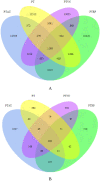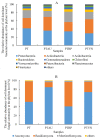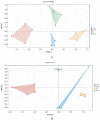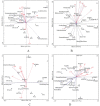Near-natural transformation of Pinus tabuliformis better improve soil nutrients and soil microbial community
- PMID: 34631311
- PMCID: PMC8465996
- DOI: 10.7717/peerj.12098
Near-natural transformation of Pinus tabuliformis better improve soil nutrients and soil microbial community
Abstract
Pinus tabulaeformis plantations have been established around northern China to restore degraded land and provide timber or fuelwood. In recent years, widely distributed monoculture P. tabulaeformis forests have been transformed into mixed forests due to various ecological problems. However, the current research on the influence of near-natural transformation of P. tabulaeformis on soil microbial diversity and community composition remains limited. Therefore, we examined the effect of forest conversion from monoculture Pinus tabuliformis (PT) to P. tabuliformis-Armeniaca vulgaris (PTAU), P. tabuliformis - Robinia pseudoacacia (PTRP), P. tabuliformis - Vitex negundo L. var. heterophylla (PTVN) forests on soil microbial community diversity and composition. The results indicated that compared to PT, PTAU, PTVN, and PTRP could enhance the soil pH, TC, TN, AN, and AK in different degrees, the most obvious in PTAU. Near-natural transformation of P. tabuliformis could improve soil bacterial Pielou_e index, and Simpson index, as well as soil fungal Chao1 index. Proteobacteria and Ascomycota were the dominant soil microbial community at the phylum level. What's more, both soil bacterial and fungal community among PT, PTAU, PTRP and PTVN showed clear different, and PTAU obviously altered the soil microbial community structure. Proteobacteria was the predominant group in PT, while, Gemmatimonadetes enriched in PTVN. Ascomycota was the predominant group in PTAU, while, Basidiomycota was the predominant group in PTRP. Near-natural transformation of P. tabuliformis could change soil microbial community via altering soil characteristics. In brief, our research results revealed the influence of tree composition and soil nutrient availability on soil microbial diversity and composition, and provided management guidance for introduction soil microbial community in forest protection and management.
Keywords: Near-natural transformation; Pinus tabuliformis; Soil characteroistics; Soil microbial community.
©2021 Yin et al.
Conflict of interest statement
The authors declare there are no competing interests.
Figures





Similar articles
-
[oil microbial biomass and enzyme activities among different artificial forests in Ziwuling, Northwest China.].Ying Yong Sheng Tai Xue Bao. 2018 Aug;29(8):2695-2704. doi: 10.13287/j.1001-9332.201808.001. Ying Yong Sheng Tai Xue Bao. 2018. PMID: 30182610 Chinese.
-
Changes in Rhizosphere Soil Fungal Communities of Pinus tabuliformis Plantations at Different Development Stages on the Loess Plateau.Int J Mol Sci. 2022 Jun 17;23(12):6753. doi: 10.3390/ijms23126753. Int J Mol Sci. 2022. PMID: 35743198 Free PMC article.
-
[Characteristics of soil microbial communities in different restoration models in the ecological immigrants' emigration area in southern Ningxia, China].Ying Yong Sheng Tai Xue Bao. 2022 Jan;33(1):219-228. doi: 10.13287/j.1001-9332.202201.036. Ying Yong Sheng Tai Xue Bao. 2022. PMID: 35224944 Chinese.
-
Root distribution characteristics of monoculture and mixture of Pinus tabuliformis and Robinia pseudoacacia plantation.Ying Yong Sheng Tai Xue Bao. 2023 Nov;34(11):2881-2888. doi: 10.13287/j.1001-9332.202311.008. Ying Yong Sheng Tai Xue Bao. 2023. PMID: 37997398 English.
-
[Ecological and physiological mechanisms of growth decline of Robinia pseudoacacia plantations in the Loess Plateau of China: A review.].Ying Yong Sheng Tai Xue Bao. 2018 Jul;29(7):2433-2444. doi: 10.13287/j.1001-9332.201807.037. Ying Yong Sheng Tai Xue Bao. 2018. PMID: 30039683 Review. Chinese.
Cited by
-
Response of soil bacteria on habitat-specialization and abundance gradient to different afforestation types.Sci Rep. 2023 Oct 24;13(1):18181. doi: 10.1038/s41598-023-44468-x. Sci Rep. 2023. PMID: 37875517 Free PMC article.
-
Effects of exogenous calcium additions on the ecological stoichiometric characteristics of various organs and soil nutrients and their internal stability in Pinus tabuliformis.Front Plant Sci. 2024 Sep 5;15:1428011. doi: 10.3389/fpls.2024.1428011. eCollection 2024. Front Plant Sci. 2024. PMID: 39301157 Free PMC article.
-
Soil properties under different ecological restoration modes for the quarry in Yanshan mountains of Hebei province, China.PeerJ. 2022 Nov 18;10:e14359. doi: 10.7717/peerj.14359. eCollection 2022. PeerJ. 2022. PMID: 36420130 Free PMC article.
-
High-throughput sequencing reveals rhizosphere fungal community composition and diversity at different growth stages of Populus euphratica in the lower reaches of the Tarim River.PeerJ. 2022 Jun 2;10:e13552. doi: 10.7717/peerj.13552. eCollection 2022. PeerJ. 2022. PMID: 35673389 Free PMC article.
References
-
- Barcenas-Moreno G, Bååth E, Rousk J. Functional implications of the pH-trait distribution of the microbial community in a re-inoculation experiment across a pH gradient. Soil Biology and Biochemistry. 2016;93:69–78. doi: 10.1016/j.soilbio.2015.10.024. - DOI
-
- Becerril-Piña R, Mastachi-Loza CA, González-Sosa E, Díaz-Delgado C, Bâ KM. Assessing desertification risk in the semi-arid highlands of central Mexico. Journal of Arid Environments. 2015;120(120):4–13. doi: 10.1016/j.jaridenv.2015.04.006. - DOI
-
- Braak CJFT, Smilauer P. Ithaca Ny: Usa Www; 2002. CANOCO reference manual and CanoDraw for Windows user’s guide: software for canonical community ordination (version 4.5)
-
- Chen GP, Shi C, Cheng SS, Zhao TJ, Liu GQ, Shi FC. The structure and soil characteristics of a Pinus tabuliformis planted forest after 60 years of natural development in North China. Silva Fennica. 2017;51(1):1709. doi: 10.14214/sf.1709. - DOI
LinkOut - more resources
Full Text Sources

